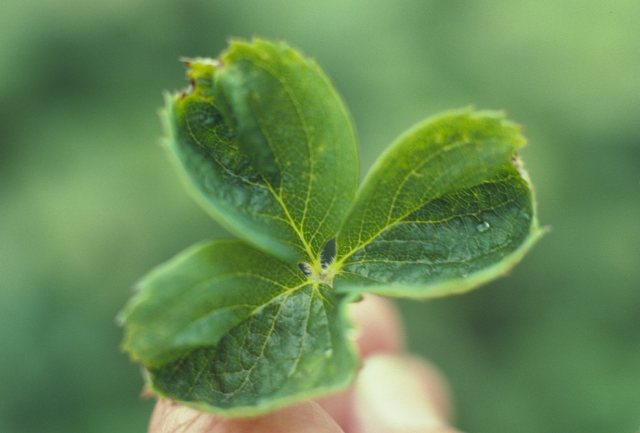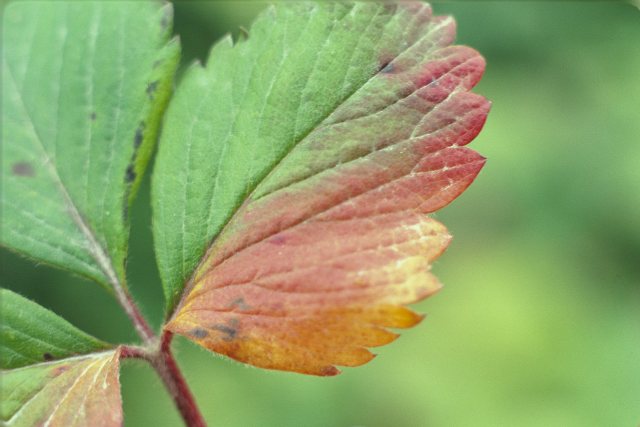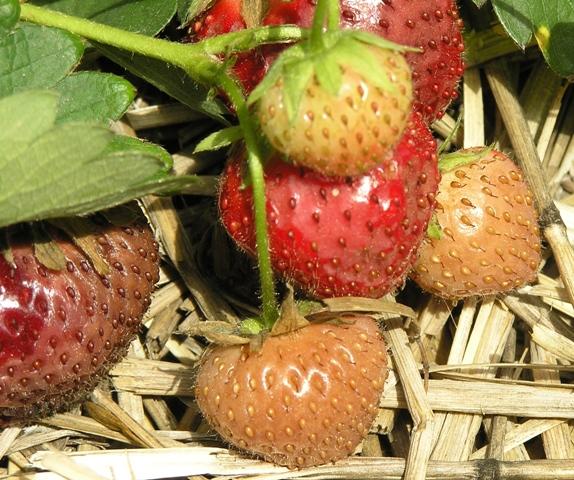Strawberry
Other Problems
- Problem Identification
- Physiological Problems
- Tip Burn
- Yellowing or Chlorosis
- Wind Damage
- Sunscald
- Stunting
- 2,4-D Damage
The ability to recognize and correct production problems early is essential for a successful strawberry operation. Shortcuts in preparing and maintaining a strawberry field will often result in serious pest problems later in the production cycle. Conduct frequent field inspections, perhaps daily during the early portion of the production cycle. Weak stands of strawberries are more prone to insect and disease attack and therefore should be monitored more frequently.
Problem Identification
Knowing the habits and damage characteristics of a disease or insect is the key to field problem diagnosis. For example, wilting of new leaves in the crown is a tell-tale sign of early cutworm damage. Quick action at this stage can minimize damage to the planting.
However, in some cases, corrective action must be taken before obvious signs of injury appear. For example, the tarnished plant bug can cause serious damage while the plant is still in the blossom stage, but injury does not become obvious until after the insect has left the blossom. Therefore, it is important to monitor the tarnished plant bug population with traps or frequent field inspections during the blossom stage. Tarnished plant bug levels of one to two nymphs per flower or higher warrants an insect control measure.
Physiological Problems
Strawberry plants are affected by a number of problems that are not caused by insects or disease. They are physiological in nature.
Tip Burn of Leaves

This condition is the result of a temporary calcium shortage. It occurs in young strawberry plants during periods with hot days and cool nights or after a frost to young unfolding leaves. The symptoms are slightly malformed leaves with dry leaf margins. This condition is usually not considered serious. Application of calcium chloride in a water solution at 1 lb./100 gals./acre (1.12 kg/1123 L/ac) as a foliar spray is helpful.
Yellowing or Chlorosis

Some cultivars appear to be more sensitive to this condition, which produces a fading or yellowing of foliage (see color section). Chlorosis development is influenced by genetic makeup of the cultivar, high soil alkalinity (eg. soil pH > 7.0) or salinity, topography and soil aeration. Temporary yellowing can occur on waterlogged soils after long periods of irrigation for frost control or excessive rainfall. Yellow strips of "mother plants" frequently occur during growth early in the season. These plants generally have suffered winter injury to the root system. In some severe cases the yellowing can be corrected by incorporating an iron chelate into the soil at the rate of 13 lb./acre (14.3 kg/ha ) of actual iron or applying as a foliar spray.
Wind Damage to Plants and Fruit
This condition can result from poorly sheltered strawberry planting. Exposure to strong winds and wind borne soil particles will cause "tar spots" on the leaves and stems. This damage is caused by a chemical change in the cell contents when they are exposed to air. The reaction is similar to exposing the surface of a sliced apple to air. Wind damage can reduce plant vigor as well as quality and shelf life of fruit from young plantings.

When fruit receives too much exposure to the sun, the skin can break down or soften, causing sunscald. The symptom is a discoloration of the fruit surface ranging from pink to off-grey. Fruit not protect by a good foliage canopy is prone to this condition. Berries on the south or west sides of rows are especially vulnerable to damage.
Stunting and Small Leaf Development
Winter injury is often the cause if these symptoms are exhibited over the whole field. Repeated freezing and thawing or low snowfall often precede this condition. The problem can be verified by cutting the plant crown vertically and examining the tissue for brown discoloured areas. Plantings that incur winter injury early in their life cycle rarely recover. Early plow down of the planting may have to be considered.
Deformed fruit showing "lines" or "folds" along the berries can be caused by 2,4-D drift at the time of fruit bud initiation. Even a minimal amount of herbicide drift can result in abnormal fruit. The period of sensitivity for June bearers is usually late fall. Day neutrals are susceptible any time during active plant growth.

